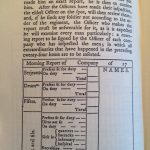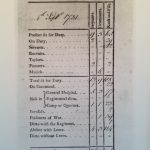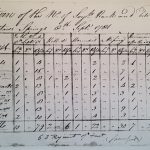Armies thrived on paperwork. With huge amounts of information to be recorded and tracked, non-commissioned officers and soldiers with good literacy, skill at basic mathematics, and steady penmanship were highly valued. Although data had to be recorded by hand, much of it was repetitive; by the era of the American Revolution, printed forms for recording routine military information were in widespread use. Printers in large cities advertised them for sale. An officer who wasn’t sure what he needed could show the printer examples from any number of military textbooks containing templates for inspection reports, duty rosters, passes, and all sorts of other frequent needs. An example appears here of a Morning Report, from the 1768 London edition of Thomas Simes’s The Military Medley. Click the images below to enlarge.
These documents, once plentiful, are quite rare today. The Peter Force Papers in the Library of Congress contains a Morning Report for the British army’s 63rd Regiment of Foot filled out on September 4, 1781. The format is not identical to that provided by Simes, but it is similar and records the same information. At a glance the information may seem mundane, but it shows the stark difference between the “paper” strength of a regiment – in this case, four hundred and twenty seven non-commissioned officers, drummers and private soldiers (the sum of the “Total Strength” figures) – and the number actually available to go into battle, a mere seventy seven (the sum of the “Present fit for Duty” figures). And go into battle they did. This report was prepared just four days before the battle of Eutaw Springs in South Carolina. The final document, also in the Peter Force Papers and entirely hand-written, shows how the severely understrength regiment fared in that fight: of eighty nine non-commissioned officers and soldiers engaged, only twenty nine remained fit for service when it was over.
















2 Comments
These ‘Primary Source’ articles are very helpful. On a different note, today is the day 240 years ago that a motley defensive line of militia from several colonies squared off against the best army in the world and held their own on a hill eventually named Breed’s. Never forget.
Well said, Mr. Steven Paul Mark!